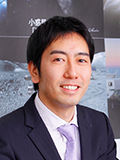Shingo Kameda

Commendation
Studies on surface and atmosphere of celestial bodies using instruments onboard spacecraft
A list of five major papers
- S. Kameda et al., Design of telescopic nadir imager for geomorphology (TENGOO) and observation of surface reflectance by optical chromatic imager (OROCHI) for the Martian Moons Exploration (MMX), Earth, Planets and Space, Volume 73, Issue 1, article id.218, 2021.
- A. Tavrov, S. Kameda, et al., Stellar Imaging Coronagraph and Exoplanet Coronal Spectrometer – Two Additional Instruments for Exoplanet Exploration Onboard The WSO-UV 1.7 Meter Orbital Telescope, Journal of Astronomical Telescopes, Instruments, and Systems, 4, 044001, 2018.
- S. Kameda et al., Ecliptic North-South Symmetry of Hydrogen Geocorona, Geophysical Research Letters 44, Issue 23, 11,706-11,712, 2017.
- S. Kameda et al., Preflight Calibration Test Results for Optical Navigation Camera Telescope (ONC-T) Onboard the Hayabusa2 Spacecraft, Space Science Review, 208, Issue 1-4, pp 17-31, 2017.
- S. Kameda et al., Interplanetary dust distribution and temporal variability of Mercury’s atmospheric Na, Geophys. Res. Lett., 36, L15201, 2009.
Major achievements
Dr. Shingo Kameda has presented unique and remarkable research results regarding the technological development of scientific instruments onboard spacecraft and their application to explorations of celestial bodies in the solar system and exoplanet observation.
Dr. Kameda has developed a high-performance optical camera on the asteroid exploration mission, Hayabusa2, and has contributed to the arrival and landing operations and understanding of asteroids, and the absorption distribution of hydrated minerals around the globe.
The Procyon spacecraft succeeded in observing the Earth’s corona using its originally developed hydrogen Lyman-alpha imager and clarified the global distribution and escaping process of exospheric hydrogen atoms.
Furthermore, he applied this research to terrestrial planets outside the solar system and made a very original observation proposal. In this way, Dr. Kameda has made various sciences possible, led Japan’s solar system exploration missions to success, and made enormous contributions to the development of earth and planetary science by his world-class development technology and his innovative ideas.
He is a researcher who should be a role model for the next generation of researchers specializing in scientific instrument development.
For these reasons, Dr. Shingo Kameda is a worthy recipient of the Nishida Prize.
Nominator
Self Recommendation
Supporters
Masato Nakamura, Makoto Taguchi
